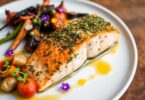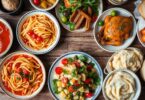The aroma of sizzling garlic and fragrant herbs signaled the start of a culinary journey in my kitchen. My grandmother’s kitchen, a sanctuary of culinary wonders, was where simple ingredients transformed into mouthwatering dishes. These dishes brought our family together. Now, I’m eager to share the secrets of creating these comforting, flavorful meals in your home.
This comprehensive guide delves into the art of cooked food. We’ll uncover essential techniques, equipment, and meal planning strategies. Whether you’re a novice or a seasoned chef, this article will equip you with the knowledge to craft recipes that are both visually stunning and bursting with flavor.
From mastering the basics of food preparation to unlocking the secrets of cooking techniques, this guide will be your ultimate resource. It will help elevate your home-cooked meals to new heights. Let’s embark on this journey through the delicious world of cooked food together!

Key Takeaways
- Explore the world of delicious cooked food and learn to create mouthwatering dishes at home
- Discover essential cooking techniques, equipment, and meal planning strategies
- Enhance your culinary skills and confidence in the kitchen
- Unlock the secrets to crafting flavorful and visually appealing recipes
- Become a master of the culinary arts and elevate your home-cooked meals
Understanding the Basics of Food Preparation
Embarking on a culinary adventure necessitates mastering the fundamentals of food preparation. Whether you’re a novice home cook or seeking to enhance your kitchen skills, understanding essential equipment, common cooking terms, and safety protocols is crucial. This knowledge significantly improves your success in the kitchen.
Essential Kitchen Equipment for Success
Equipping your kitchen with the right tools is paramount for efficient and effective cooking. Begin by investing in high-quality cookware, such as sturdy pots, pans, and baking sheets. A sharp set of knives, a reliable food processor, and precise measuring cups and spoons are also essential. Furthermore, consider acquiring a meat thermometer, a good set of mixing bowls, and versatile utensils to enhance your cooking experience.
Fundamental Cooking Terms Explained
Familiarizing yourself with common cooking terminology can demystify the world of home cooking. Understanding terms like sautéing, simmering, baking, and broiling can instill confidence in navigating recipes. Explore the nuances between dicing, mincing, and chopping, and learn to measure ingredients precisely.
Safety First: Kitchen Protocols
Maintaining a safe and well-organized kitchen is vital for both home cooking and cooking classes. Establish good food safety habits, such as thoroughly washing your hands, cleaning all surfaces, and properly storing and handling ingredients. Be cautious of sharp tools, hot surfaces, and potential fire hazards. Familiarize yourself with basic first aid techniques in case of minor accidents.
By mastering the basics of food preparation, you’ll lay the groundwork for creating delicious and nutritious meals in your own kitchen. Embrace the journey, and don’t hesitate to experiment and learn along the way!
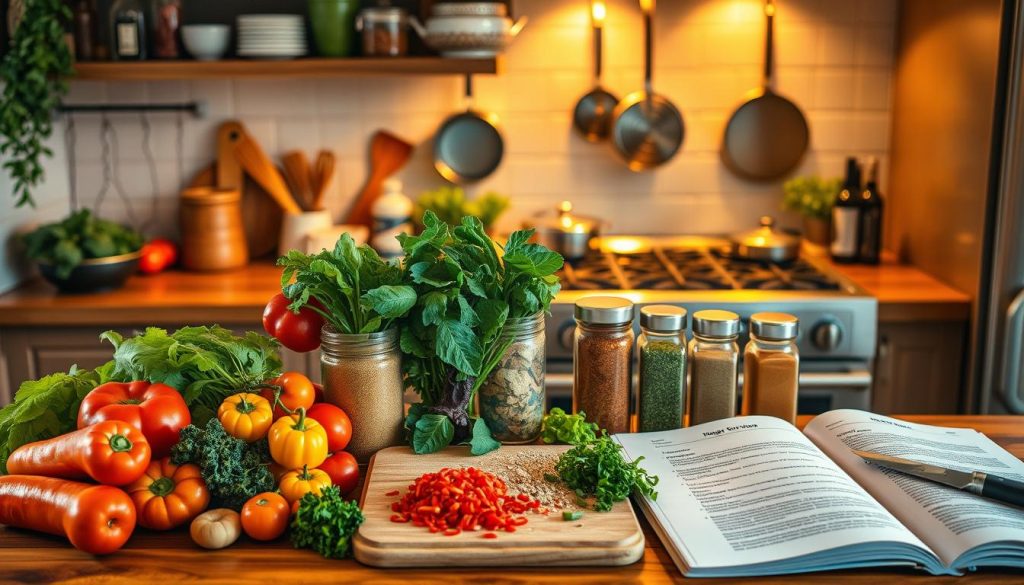
“Cooking is not about fancy ingredients or complicated techniques. It’s about love, connectivity, and nourishment for the body and soul.”
– Julia Child, renowned chef and author
The Art of Meal Planning and Preparation
Embarking on the journey of meal planning and preparation is pivotal for savoring nutritious, home-cooked meals effortlessly. Whether you’re a high-strung professional or a fervent advocate for health, embracing effective strategies can significantly reduce your time commitment, alleviate stress, and foster a balanced dietary regimen.
At the core of meal preparation lies the meticulous planning of your weekly menu. Allocate time to scrutinize your forthcoming schedule, reflect on your dietary prerequisites, and devise a plan that harmonizes with your lifestyle. This approach not only guarantees the availability of necessary ingredients but also enhances your organizational prowess, averting the chaos of last-minute dinner preparations.
- Identify your family’s cherished meal prep ideas and integrate them into your weekly schedule.
- Engage in culinary exploration by testing new recipes that resonate with your healthy eating aspirations.
- Utilize batch cooking and meals amenable to freezing to streamline your meal planning endeavors.
Streamlining the cooking process is another critical component of meal preparation. Invest in indispensable kitchen tools, hone fundamental cooking techniques, and establish a workflow that aligns with your lifestyle. By proactively planning and optimizing your cooking routine, you can dramatically decrease the time and effort invested in preparing delectable, wholesome meals.
“Meal planning is the secret to healthy eating and a stress-free kitchen. With a little forethought, you can enjoy the benefits of home-cooked meals without the hassle.”
It is crucial to recognize that meal planning and preparation is an art form, not a burdensome task. Embrace the journey, experiment with novel concepts, and discover the method that resonates with your preferences. Through consistent practice, you will adeptly navigate the realm of meal prep, reaping the rewards of a well-rounded, fulfilling diet.
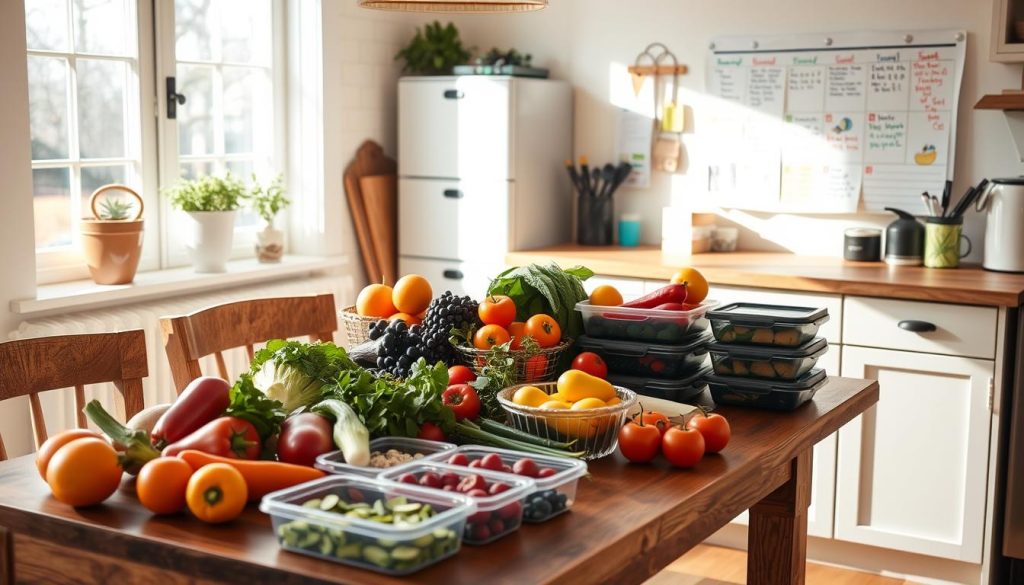
Essential Cooking Techniques for Perfect Results
Cooking transcends mere sustenance, evolving into an intricate art form, replete with diverse techniques. Each method, whether favored by a seasoned chef or a novice, significantly influences the dish’s quality and taste. Mastery of these fundamental cooking methods is crucial for elevating culinary creations.
Dry Heat Methods
Dry heat cooking techniques employ direct heat application to food, eschewing moisture. This category encompasses baking, roasting, grilling, and sautéing. Each technique imbues distinct flavors and textures, making them versatile for a wide array of ingredients and recipes.
Moist Heat Methods
Conversely, moist heat cooking methods utilize liquids or steam to cook food. Techniques such as boiling, simmering, poaching, and steaming are particularly adept at tenderizing tough meats, cooking delicate seafood, and preserving the natural flavors and nutrients of vegetables.
Combination Cooking Methods
Some techniques blend dry and moist heat to achieve optimal results. Braising and stewing exemplify this, involving initial searing followed by slow cooking in liquid. This method fosters the development of rich, complex flavors and tender textures.
Grasping these fundamental cooking techniques unlocks a plethora of culinary possibilities. Whether you’re a cooking for beginners or a seasoned cooking techniques aficionado, comprehending the subtleties of cooking methods and cooking tutorials empowers you to craft delectable, restaurant-grade meals within your own kitchen.
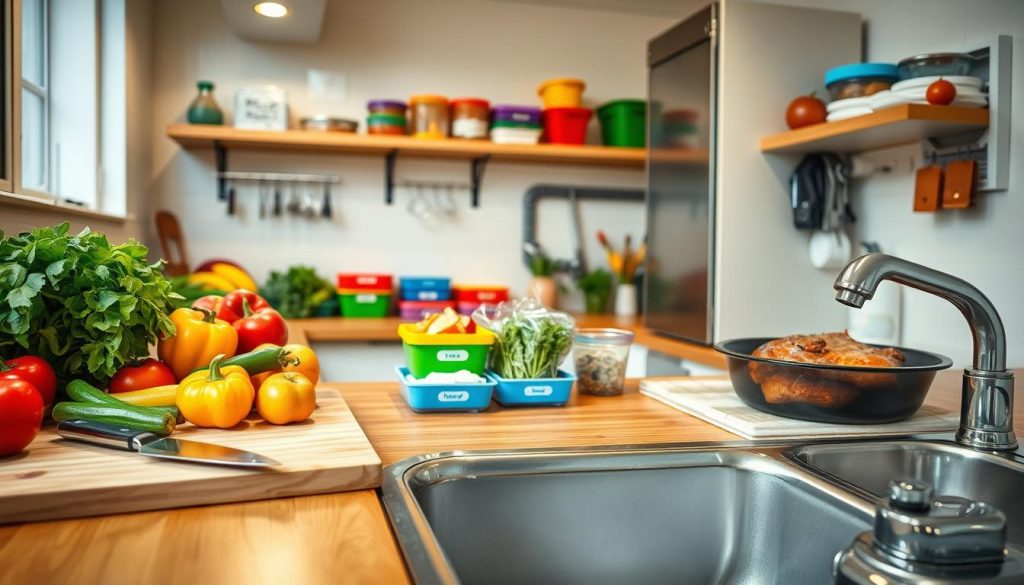
Mastering Cooked Food: From Basic to Advanced
The transition from basic to advanced culinary skills in the realm of delicious cooked food is a journey filled with excitement. Whether you are a novice home cook or a seasoned chef, this section aims to elevate your culinary prowess. It will unveil the essential techniques and tricks necessary to transform your delicious cooked food into a true masterpiece.
Begin with the fundamentals – mastering techniques such as sautéing, roasting, and simmering. Enhance your kitchen skills and confidence by mastering simple, easy meal ideas. As you advance, delve into more intricate methods, including braising, poaching, and pan-frying, to fully exploit the potential of your home-cooked meals.

Delve into the complexities of flavor development, learning to balance seasoning, acidity, and aromatics. This will enable you to craft delicious cooked food that excites the senses. Experiment with various cooking times and temperatures to achieve the ideal texture and doneness, whether searing a steak or simmering a hearty stew.
As you progress, explore the art of presentation. Discover the techniques of plating and garnishing, transforming your meals guide into visually stunning dishes that will surely impress. Embrace the joy of creativity and let your culinary skills shine.
“Cooking is like love. It should be entered into with abandon or not at all.”
– Harriet Van Horne
The journey of mastering cooked food is ongoing. Embrace the learning process, experiment with new techniques, and don’t hesitate to venture beyond your comfort zone. With unwavering dedication and a passion for easy meal ideas, you will unlock the secrets to creating delicious cooked food that will delight your senses and impress your guests.
Smart Shopping: Ingredients That Make the Difference
Embarking on the journey of home cooking necessitates the selection of superior ingredients. The quest for healthy eating, effortless cooking, or the preparation of nutritious meals hinges on the quality and freshness of these components. This segment delves into indispensable guides, aiming to transform you into a discerning shopper. It seeks to enhance your culinary prowess.
Seasonal Produce Guide
Fruits and vegetables are the quintessence of any dish, embodying both health and flavor. Opting for seasonal produce ensures peak freshness and taste, while also promoting local agriculture and diminishing environmental footprint. Our guide to seasonal produce equips you with knowledge of the year’s best offerings. This guarantees access to the most nutritious meals.
Pantry Essentials Checklist
A well-stocked pantry serves as the cornerstone for easy cooking and healthy eating. Our checklist for pantry essentials compiles a diverse array of staples, encompassing whole grains, legumes, spices, and condiments. Armed with these food preparation essentials, you’ll effortlessly craft delectable and nutritious meals.
Quality Proteins Selection
Proteins are pivotal in healthy eating, serving as the foundational elements for muscle development and repair. The selection of quality proteins demands consideration of sustainability, processing techniques, and nutritional content. Our guide navigates the complex world of proteins, empowering you to make informed choices. These choices will elevate the flavor and nutritional value of your home-cooked dishes.

“The quality of the ingredients you use is the single most important factor in how good your food will taste.”
– Marco Pierre White, renowned British chef
Quick and Easy Weeknight Dinner Solutions
The demands of work, family, and household duties often leave little time for cooking. Yet, we present a selection of quick meals and simple meals to ease your weeknight dinner preparations. These dishes promise to delight your palate without straining your schedule.
Discover the efficiency of quick meals and simple meals in transforming your evenings. This section focuses on quick dinner recipes and dinner ideas that are not only swift but also nourishing. It aims to provide you with solutions that allow for a speedy yet satisfying mealtime experience.
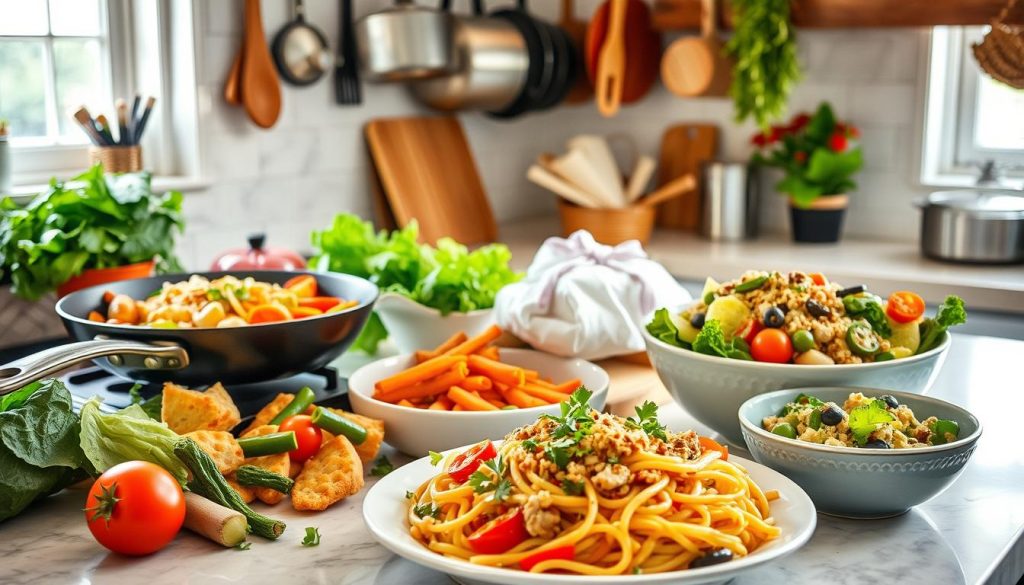
Our curated list includes one-pan wonders and 30-minute marvels, all crafted to simplify your weeknight dinners. These recipes leverage pantry staples and efficient cooking methods, ensuring delicious outcomes with minimal effort.
“Simplicity is the ultimate sophistication.” – Leonardo da Vinci
Whether you’re in the mood for a comforting quick dinner recipe or a vibrant dinner idea, this collection caters to all tastes. Explore these stress-free, satisfying options and watch as your family clamors for more.
- One-Pot Chicken Teriyaki Stir-Fry
- 5-Ingredient Baked Salmon with Roasted Vegetables
- Creamy Garlic Pasta with Sautéed Shrimp
- 30-Minute Beef and Broccoli Bowls
- Lentil and Sweet Potato Curry
Indulge in the pleasure of quick meals and simple meals that pack a punch in terms of taste. With these quick dinner recipes and dinner ideas, you’ll swiftly reclaim your weeknights, enjoying homemade delights with ease.
Healthy Cooking Methods for Nutritious Meals
Preparing healthy meals doesn’t have to be complicated. By understanding a few key healthy cooking techniques, you can create delicious and nutritious recipes that nourish your body. In this section, we’ll explore some essential methods for healthy home-cooked meals.
Low-Fat Cooking Techniques
Reducing the fat content in your cooking is a simple way to boost the health benefits of your meals. Try techniques like:
- Baking, broiling, or grilling instead of frying
- Using non-stick cookware to minimize the need for added oils
- Substituting low-fat or non-fat dairy products for full-fat versions
- Trimming visible fat from meats before cooking
Preserving Nutrients While Cooking
It’s important to preserve the nutritional value of your ingredients when cooking. Some tips include:
- Steaming or sautéing vegetables instead of boiling to retain more vitamins and minerals
- Cooking meat and fish at lower temperatures to avoid overcooking and nutrient loss
- Incorporating fresh herbs and spices, which are packed with antioxidants
Portion Control Guidelines
Achieving the right balance of healthy meals means being mindful of portion sizes. Follow these guidelines to ensure you’re eating the right amount:
- Divide your plate into quarters, with one quarter for protein, one for complex carbs, and two for vegetables
- Measure out standard serving sizes, such as 4-6 oz of meat or 1/2 cup of cooked grains
- Avoid second helpings and practice mindful eating to recognize when you’re full
By incorporating these healthy cooking methods into your routine, you can create delicious and nutritious recipes that support your overall well-being.

Time-Saving Kitchen Hacks and Tips
In the fast-paced world of modern living, every second is precious when cooking. Fortunately, numerous cooking hacks and quick cooking tips exist to optimize your kitchen time. These food hacks encompass everything from innovative storage solutions to ingenious meal prep strategies, ensuring cooking made easy and efficient.
Begin by honing your meal planning skills. Allocate a few minutes each week to list your family’s preferred dishes and devise a simple weekly menu. This approach not only saves time but also minimizes food waste. Additionally, consider doubling or tripling your favorite recipes and freezing the excess for hectic weeknights.
The right kitchen equipment is crucial for effective cooking hacks. Invest in a sharp knife set, a superior blender, and a robust slow cooker to enhance your meal prep efficiency. Maximize your appliance capabilities by batch-cooking staples like grains, proteins, and roasted vegetables, which can be repurposed throughout the week.
- Chop vegetables in advance and store them in airtight containers for quick meal assembly.
- Use a slow cooker to prepare soups, stews, and even entire meals hands-free.
- Freeze herbs, broths, and sauces in ice cube trays for easy portioning and quick flavor boosts.
Lastly, leverage food hacks for effortless cleanup. Utilize parchment paper or aluminum foil on baking sheets for effortless post-cooking cleanup. Immediately submerge pots and pans in hot, soapy water after use to prevent stubborn food residue from adhering.
“The key to cooking made easy is finding little tricks and shortcuts that simplify the process without sacrificing flavor or quality.”
By integrating these cooking hacks and quick cooking tips into your daily routine, you’ll dedicate less time to cooking and more to relishing homemade meals with your family.

Creating Flavorful Dishes with Herbs and Spices
Elevate your culinary prowess and captivate your taste buds with the transformative power of herbs and spices. These ingredients can metamorphose the most basic dishes into gastronomic masterpieces, imbuing them with irresistible aromas and tantalizing flavors. Delve into the art of crafting delectable recipes, homemade delights, and comforting dishes with our comprehensive guide to harnessing the essence of herbs and spices.
Essential Spice Combinations
Unveil the enchantment of spice blends and their ability to intensify flavors in your culinary creations. From the warm, smoky essence of cumin and chili powder to the bright, citrusy fusion of coriander and lemon zest, a vast realm of spice synergies awaits exploration. Engage in experimentation with these fundamental spice combinations to forge layers of flavor that will elicit repeated requests for seconds from your family and friends.
Fresh vs. Dried Herbs
The distinction between fresh and dried herbs can significantly influence your cooking outcomes. Fresh herbs are renowned for their vibrant, fragrant essence, injecting a burst of flavor into your dishes. Conversely, dried herbs offer a more concentrated taste, making them ideal for prolonged cooking periods. Acquaint yourself with the distinct characteristics of each herb and master the art of seamlessly integrating them into your homemade creations and recipes.
Building Flavor Profiles
The art of crafting intricate, balanced flavor profiles is paramount in creating dishes that leave a lasting impression. Engage in experimentation with the layering of different herbs and spices to uncover the quintessential harmony of tastes. Remember, the adventure of discovering novel flavor combinations is an integral part of the culinary journey. Embrace your inner culinary artist and allow your creativity to flourish as you craft delicious comfort food and exquisite meals.
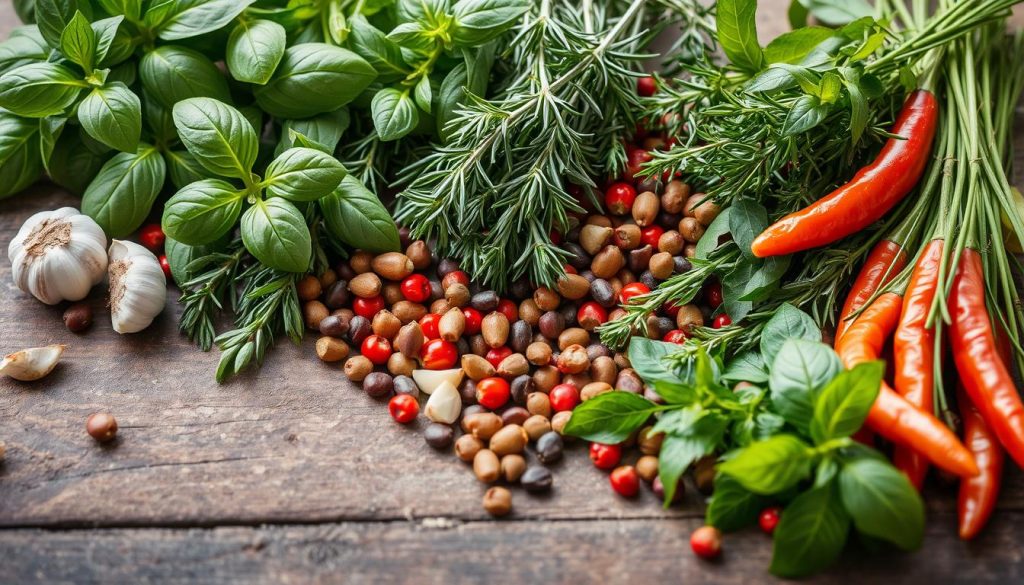
Meal Prep Strategies for Busy Lives
In today’s fast-paced world, maintaining a healthy and balanced diet poses a significant challenge. Meal prep emerges as a transformative strategy, capable of revolutionizing your weekly routine. It is particularly beneficial for working professionals, busy parents, and individuals prioritizing efficiency. These meal prep tips empower you to manage your meals effectively, ensuring access to nutritious and delicious food.
The primary benefit of meal prep lies in its time-saving potential. By allocating a few hours on the weekend to food prep, you can prepare a variety of ready-to-go meals and snacks. This approach eliminates the daily struggle to decide on meals, providing you with healthier meal ideas for busy people at your fingertips.
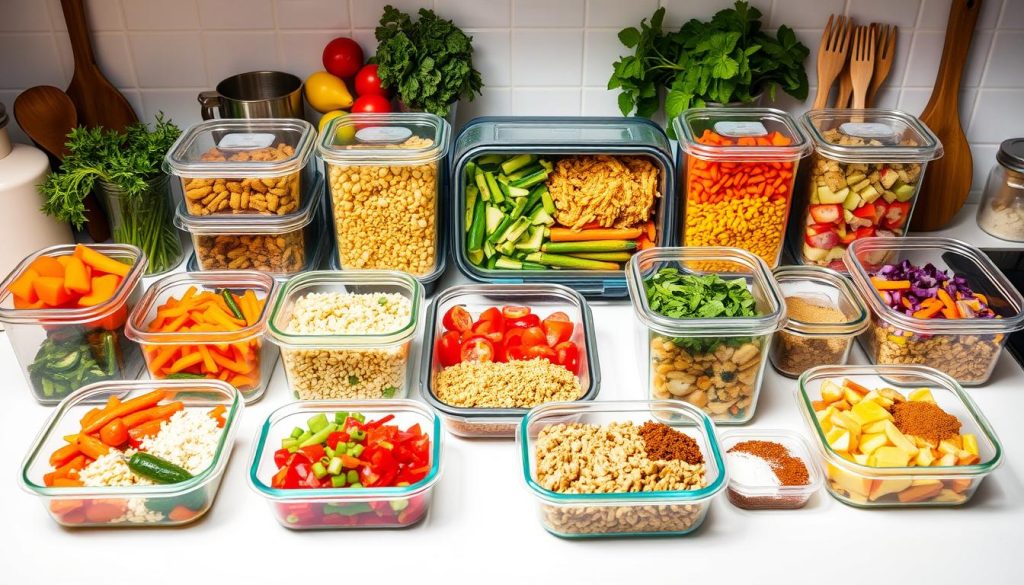
Effective meal prep also hinges on organization. Investing in quality storage containers and labeling them with contents and dates is crucial. This strategy optimizes your fridge and freezer space, minimizes food waste, and facilitates the quick retrieval of pre-prepared meals or snacks.
- Batch cook staple proteins like chicken, ground turkey, or tofu to use in various dishes throughout the week.
- Prep chopped veggies, pre-washed greens, and other ingredients that can be easily combined into quick salads or stir-fries.
- Make a big pot of whole grains like quinoa, brown rice, or farro to use as a base for multiple meals.
Meal prep transcends mere efficiency; it’s about savoring the process and adapting it to your unique lifestyle. Experiment with diverse recipes, explore novel flavors, and establish a rhythm that keeps your meals engaging. With thoughtful planning and preparation, weeknight dinners can transform into a delightful and stress-free endeavor.
Family-Friendly Cooking Made Simple
Mealtime can be a daunting task with diverse tastes and preferences in the household. Fear not, as we present strategies for crafting family meals that cater to all ages. This section is your compass for effortless family dinner ideas, from kid-approved recipes to engaging cooking together activities.
Kid-Approved Recipes
Conquering the challenge of pleasing picky eaters requires a strategic approach. Engage your little ones in the cooking process, allowing them to choose recipes and assist in the kitchen. This not only enhances their interest in the meal but also imparts essential life skills.
Cooking Together Activities
Cooking with kids is a rewarding experience for the whole family. Allocate time for family meals where everyone contributes, whether it’s measuring, mixing, or decorating. These activities create lasting memories, promote togetherness, and instill appreciation for home-cooked meals.
Picky Eater Solutions
Overcoming the hurdle of picky eaters requires innovative strategies. Experiment with various flavors, textures, and presentations to discover what appeals to your children. Lead by example, making mealtime a positive and encouraging experience.

“Cooking with kids is not just about making food – it’s about making memories.”
Food Storage and Leftover Management
Maintaining food safety and reducing food waste are paramount in a well-stocked kitchen. Discover the art of food storage and the ingenuity of repurposing leftovers into delectable new dishes.
Mastering Food Storage
Proper food storage is crucial for preserving ingredients’ freshness and preventing foodborne illness. Adhere to these food safety tips:
- Refrigerate perishable items at the correct temperatures to extend their shelf life.
- Utilize airtight containers or resealable bags to lock in freshness and prevent cross-contamination.
- Regularly check expiration dates and rotate your stock to ensure you’re using the oldest items first.
Embracing Leftover Magic
Transforming leftovers into new, delectable meal solutions is a fantastic way to reduce food waste and maximize your cooking efforts. Explore these easy food ideas:
- Repurpose cooked proteins like chicken or beef into salads, sandwiches, or stir-fries.
- Use leftover vegetables in frittatas, soups, or fried rice dishes.
- Get creative with leftover pasta or grains by turning them into casseroles or veggie-packed fried “rice” dishes.
With a dash of creativity and these food storage and leftover management tips, your kitchen will operate efficiently. Your meals will be both scrumptious and economical.
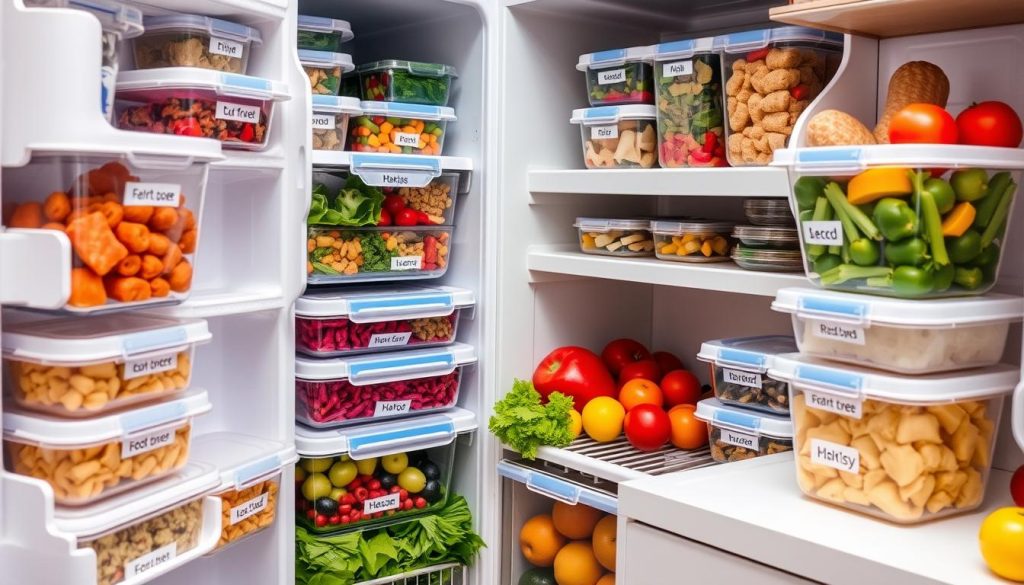
Troubleshooting Common Cooking Problems
Cooking, though rewarding, often presents challenges. Whether novice or seasoned, possessing troubleshooting techniques is crucial. This section aims to equip you with practical solutions to common cooking issues, enhancing your confidence and skill in the kitchen.
Fixing Kitchen Mishaps
Ever encountered an overly salty dish or a tough, dry piece of meat? These problems can be rectified with the right approach. To counterbalance excessive seasoning, introduce more of the other ingredients or a splash of acid, such as lemon juice or vinegar. For tough meat, employ a mallet for tenderization or baste with a flavorful liquid during cooking.
Temperature Control Tips
Accurate temperature control is essential for achieving the ideal texture and doneness. For beginners, utilizing a reliable meat thermometer is key. It ensures proteins reach the correct internal temperature. Adjust the heat as necessary to avoid burning or undercooking. If a dish cooks too quickly, reduce the heat; if it’s too slow, slightly increase the temperature.
Texture Adjustments
- Dealing with soggy vegetables or dry baked goods? Simple cooking tips for texture adjustments include:
- Pat dry ingredients before cooking to manage moisture
- Introduce a small amount of liquid or fat to dry dishes
- Try different cooking methods, like roasting over steaming, for the desired texture
Remember, cooking tips and easy recipes for beginners are about personalizing your cooking. Feel free to experiment and adjust until you achieve the perfect outcome.
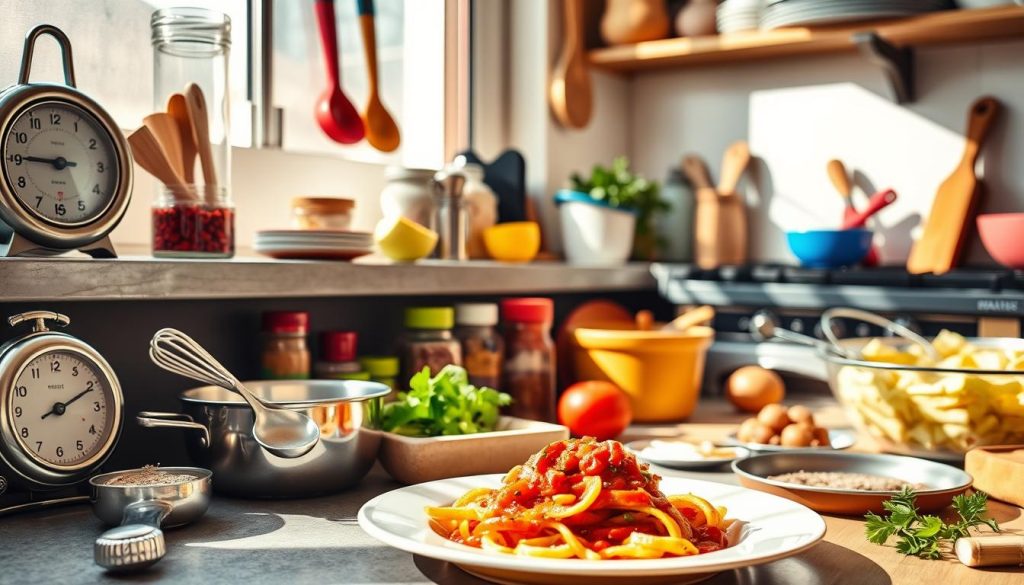
“The most important thing is to get the fundamentals right. If you’ve got a good foundation in technique, you can build great things.”- Alton Brown, American television personality and author
Conclusion
Through this comprehensive guide, you’ve acquired profound knowledge and skills to enhance your home cooking. You now understand the basics of food preparation and have mastered key techniques. This equips you to prepare tasty homemade meals that will undoubtedly impress.
The essence of cooking lies in the freedom to experiment and explore new flavors. It’s about unleashing your culinary creativity. Whether you’re preparing easy to cook meals for hectic weeknights or creating best home-cooked meals for special events, the knowledge you’ve gained will guide you to culinary triumph.
Embrace the art of homemade dishes and continue to expand your cooking horizons. With the appropriate tools, techniques, and a commitment to learning, you’ll craft meals that not only nourish but also delight. The possibilities are vast, so embark on this culinary adventure, get cooking, and relish the journey ahead.
FAQ
What are the essential kitchen equipment I need to start cooking?
Essential kitchen equipment for home cooking includes a high-quality chef’s knife and a cutting board. Additionally, you’ll need pots and pans, baking sheets, mixing bowls, and measuring cups and spoons. The right tools significantly enhance the cooking experience, making it both easier and more enjoyable.
How can I plan and prepare meals effectively?
Effective meal planning and preparation involve several steps. First, create a weekly menu and a corresponding grocery list. Then, engage in batch cooking and prep ingredients in advance. This approach saves time, reduces stress, and ensures balanced, healthy meals throughout the week.
What are the different cooking techniques I should know?
Familiarize yourself with various cooking techniques. Dry heat methods, such as baking, roasting, and sautéing, are crucial. Moist heat methods, including boiling, steaming, and braising, also play a significant role. Additionally, understanding combination cooking methods, like stir-frying and slow cooking, is essential for achieving the desired texture and flavor in your dishes.
How can I ensure my home-cooked meals are nutritious?
To ensure nutritious meals, focus on using healthy cooking methods. Techniques like steaming, poaching, and roasting help preserve nutrients. Additionally, balance your meals with a variety of fresh produce, lean proteins, whole grains, and healthy fats.
What are some time-saving kitchen hacks and tips?
Time-saving kitchen hacks include prepping ingredients in advance and utilizing a slow cooker or Instant Pot for hands-off cooking. Creative ways to repurpose leftovers can also streamline the cooking process. These strategies make it easier to prepare delicious, home-cooked meals efficiently.
How can I get my family involved in the cooking process?
Engaging your family in cooking can be both fun and educational. Assign age-appropriate tasks, such as measuring ingredients or assembling simple dishes, to your kids. Plan family cooking activities, like making homemade pizzas or baking cookies together, to foster a sense of togetherness and culinary exploration.
How can I properly store and manage food leftovers?
Proper storage and management of food leftovers are critical for food safety and waste reduction. Store leftovers in airtight containers and refrigerate or freeze them promptly. When reheating, ensure the food reaches the recommended safe internal temperature. Repurpose leftovers creatively to minimize waste and enhance culinary creativity.
How do I troubleshoot common cooking problems?
Troubleshooting common cooking problems requires a systematic approach. For over-seasoning, adjust the seasoning accordingly. Use a thermometer to ensure proper cooking temperatures. Make texture adjustments as needed. With practice and problem-solving skills, you can overcome these challenges and enhance your cooking abilities.


